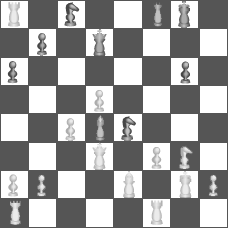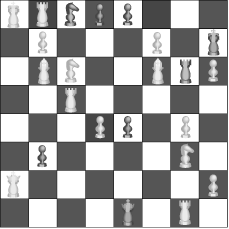|


FIGURE 2.1 Chess board positions used in memory experiments. SOURCE:
Adapted from Chase and Simon (1973).
|
|
In one study, a chess master, a Class A player (good but not a master),
and a novice were given 5 seconds to view a chess board position from
the middle of a chess game; see Figure 2.1. After 5 seconds the board
was covered, and each participant attempted to reconstruct the board
position on another board. This procedure was repeated for multiple
trials until everyone received a perfect score. On the first trial, the
master player correctly placed many more pieces than the Class A player,
who in turn placed more than the novice: 16, 8, and 4, respectively.
However, these results
occurred only when the chess pieces were arranged in configurations that
conformed to meaningful games of chess. When chess pieces were
randomized and presented for 5 seconds, the recall of the chess master
and Class A player were the same as the novice--they placed from 2 to 3
positions correctly. Data over trials for valid and random middle games
are shown in Figure 2.2.
|